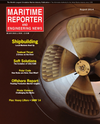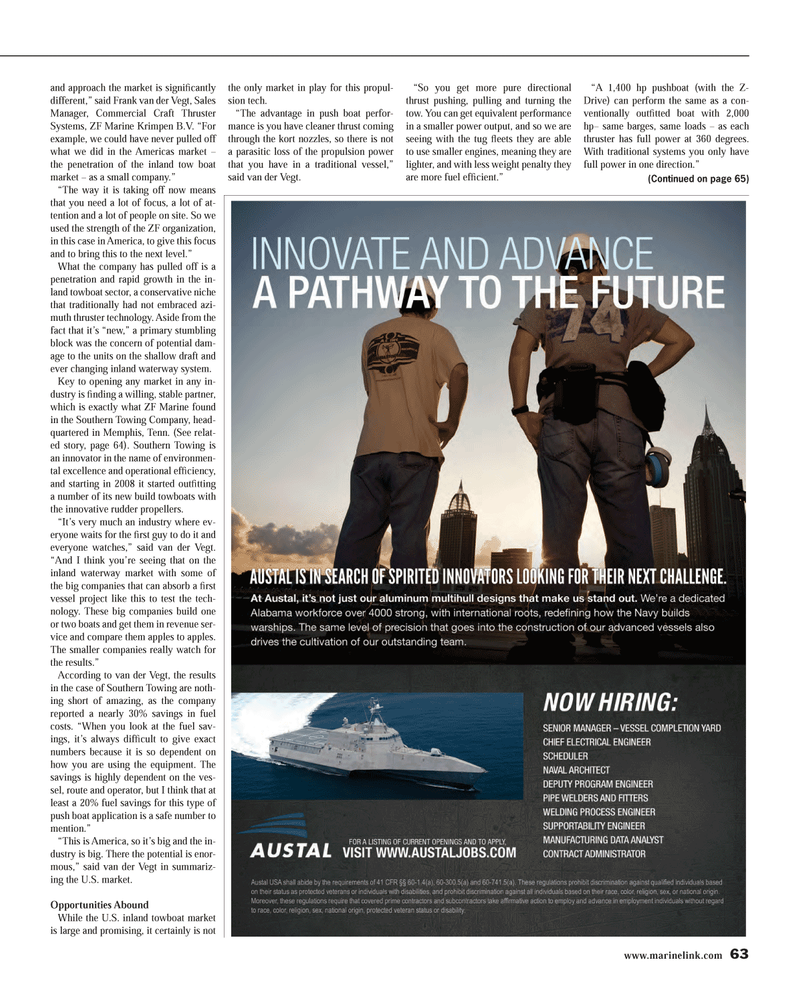
Page 63: of Maritime Reporter Magazine (August 2014)
Shipyard Edition
Read this page in Pdf, Flash or Html5 edition of August 2014 Maritime Reporter Magazine
www.marinelink.com 63and approach the market is signiÞ cantly different,? said Frank van der Vegt, Sales Manager, Commercial Craft Thruster Systems, ZF Marine Krimpen B.V. ?For example, we could have never pulled off what we did in the Americas market ? the penetration of the inland tow boat market ? as a small company.? ?The way it is taking off now means that you need a lot of focus, a lot of at-tention and a lot of people on site. So we used the strength of the ZF organization, in this case in America, to give this focus and to bring this to the next level.?What the company has pulled off is a penetration and rapid growth in the in-land towboat sector, a conservative niche that traditionally had not embraced azi-muth thruster technology. Aside from the fact that it?s ?new,? a primary stumbling block was the concern of potential dam-age to the units on the shallow draft and ever changing inland waterway system. Key to opening any market in any in-dustry is Þ nding a willing, stable partner, which is exactly what ZF Marine found in the Southern Towing Company, head- quartered in Memphis, Tenn. (See relat- ed story, page 64). Southern Towing is an innovator in the name of environmen-tal excellence and operational efÞ ciency, and starting in 2008 it started outÞ tting a number of its new build towboats with the innovative rudder propellers.?It?s very much an industry where ev- eryone waits for the Þ rst guy to do it and everyone watches,? said van der Vegt. ?And I think you?re seeing that on the inland waterway market with some of the big companies that can absorb a Þ rst vessel project like this to test the tech-nology. These big companies build one or two boats and get them in revenue ser- vice and compare them apples to apples. The smaller companies really watch for the results.?According to van der Vegt, the results in the case of Southern Towing are noth- ing short of amazing, as the company reported a nearly 30% savings in fuel costs. ?When you look at the fuel sav-ings, it?s always dif Þ cult to give exact numbers because it is so dependent on how you are using the equipment. The savings is highly dependent on the ves-sel, route and operator, but I think that at least a 20% fuel savings for this type of push boat application is a safe number to mention.? ?This is America, so it?s big and the in- dustry is big. There the potential is enor- mous,? said van der Vegt in summariz- ing the U.S. market.Opportunities AboundWhile the U.S. inland towboat market is large and promising, it certainly is not the only market in play for this propul-sion tech.?The advantage in push boat perfor- mance is you have cleaner thrust coming through the kort nozzles, so there is not a parasitic loss of the propulsion power that you have in a traditional vessel,? said van der Vegt. ?So you get more pure directional thrust pushing, pulling and turning the tow. You can get equivalent performance in a smaller power output, and so we are seeing with the tug ß eets they are able to use smaller engines, meaning they are lighter, and with less weight penalty they are more fuel efÞ cient.??A 1,400 hp pushboat (with the Z- Drive) can perform the same as a con-ventionally outÞ tted boat with 2,000 hp? same barges, same loads ? as each thruster has full power at 360 degrees. With traditional systems you only have full power in one direction.?(Continued on page 65)MR #8 (58-63).indd 63MR #8 (58-63).indd 638/11/2014 11:22:49 AM8/11/2014 11:22:49 AM

 62
62

 64
64
